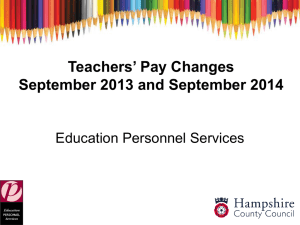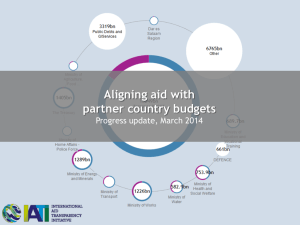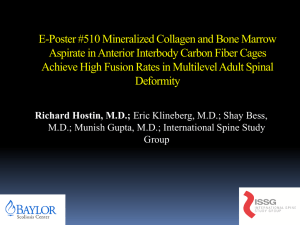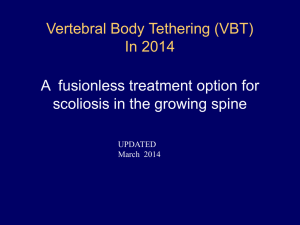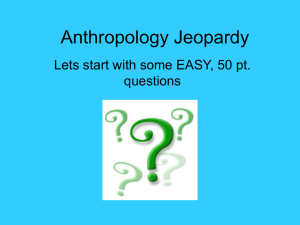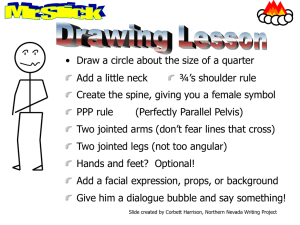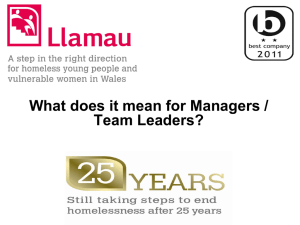Leg pain - Mehtaspine
advertisement
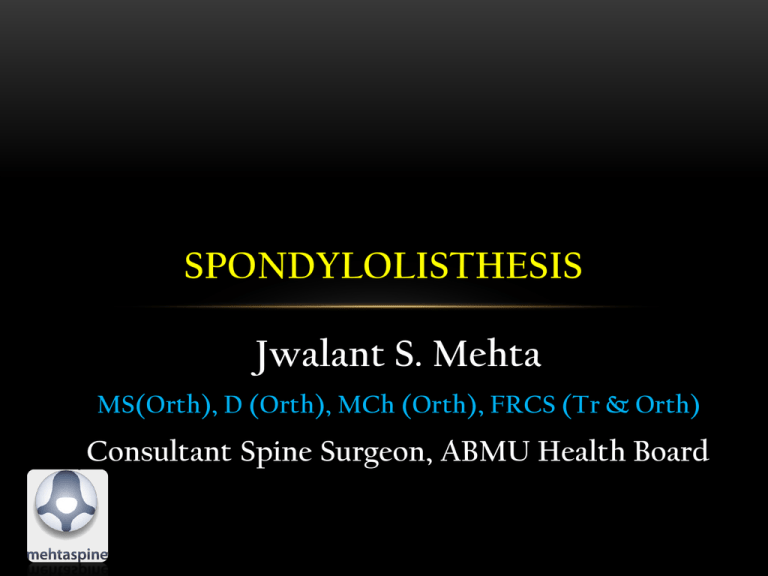
SPONDYLOLISTHESIS Jwalant S. Mehta MS(Orth), D (Orth), MCh (Orth), FRCS (Tr & Orth) Consultant Spine Surgeon, ABMU Health Board OUTLINE OF THE TALK ¤ Classification ¤ Natural history ¤ Patho-physiology ¤ Treatment rationale ¤ Cases SPONDYL OLISTHESIS 1741 Nicholas Andry: hollow back 1782 Herbiniaux Belgian obstetrician 1854 Kilian slow displacement ‘Spondylolisthesis’ 1855 Roberts: No slip if arch intact CLASSIFICATIONS Newman & Stone JBJS Br 1963; 45: 39 - 59 Type Name Description I Congenital Dysplastic abnormalities II Isthmic A Lytic (stress fracture) B Healed fracture (elongated, intact) C Acute high energy fracture III Degenerative Segmental instability IV Traumatic Fracture of hook other than pars V Pathologic Underlying pathology VI Iatrogenic Surgical excision of posterior elements Wiltse, Newmann, MacNab Clin Orthop 1976 MEYERDINGS GRADES Low Grade High Grade I II III IV V SLIP ANGLE Important in grades III – V SPINO-PELVIC MEASURES PELVIC INCIDENCE Pelvic tilt PI = PT + SS Sacral slope Low PT High SS High PT Low SS RELEVANCE OF PELVIC MEASURES ¤ PI quantifies the pelvic shape ¤ Pelvic morphology and spino-pelvic balance are abnormal in spondylolisthesis PATHO-PHYSIOLOGY HOOK AND CATCH Hook: ¤ Pedicle ¤ Pars inter-articularis ¤ Inferior process of the cephalad level Catch: ¤ Superior process of the caudal level PATHOPHYSIOLOGY ¤ Dysplastic pathway ¤ Traumatic pathway Dysplastic pathway Traumatic pathway Weakness in the hook & catch mechanism Repetitive cyclic loads (sports) Body weight transmitted through weak zone Stress fracture of a Normal pars Soft tissue restraints: plastic deformation Hard cortical pars predisposes to fatigue fracture and non-union Growth plate overloaded Predisposes to a vertical subluxation DYSPLASTIC CHANGES ¤ Proximal sacral rounding ¤ Trapezoidal L5 ¤ Vertical sacrum ¤ Junctional kyphosis ¤ Compensatory hyper-lordosis Contributes to the mechanics of progression, but not causation PROXIMAL SACRAL ROUNDING Yue Spine 2005 PROXIMAL SACRAL ROUNDING DISCAL OVER-LOADING ¤ Both the pathways lead to ↑ shear loads, axial loads remaining constant ¤ Premature disc degeneration Alternative loading pathway Haher Spine 1994 The pain generators: Back pain ¤ Chronic muscle spasm (protective): ‘painful’ pars Annular tears Root compression / traction Leg pain is the most common symptom Moller Spine 2000 THE PAIN GENERATORS: LEG PAIN ¤ L5 compression / traction ¤ Abnormal motion ¤ Facet joint arthrosis ¤ Pars scar ¤ The disc above far-lateral CLINICAL EVALUATION: HISTORY ¤ Symptoms: Back pain Leg pain Neurology ¤ Severity ¤ Activities of daily living CLINICAL EVALUATION: EXAMINATION ¤ Range and rhythm of trunk motion ¤ Neurology ¤ Sagittal alignment & gait SAGITTAL ALIGNMENT ¤ Stance ¤ Gait ¤ Head over pelvis ¤ Hips and knees IMAGING ¤ Erect radiographs: AP Lateral (to include the hips) ¤ MRI; CT ¤ Occasionally: SPECT; Dynamic radiographs; Discography PURPOSE OF IMAGING ¤ Disc degeneration (MRI / CT) ¤ Facet joint orientation, tropism, degeneration (MRI / CT) ¤ Pelvic and spinal measures (Erect xrays) DISC DEGENERATION DISC DEGENERATION: MRI Grade I Grade II Grade III Grade IV Grade V Pfirrmann et al Spine 2001 FACET JOINTS FACET JOINTS: ORIENTATION & TROPISM ¤ Mean facet joint angle: Sagittal: anterior forces Don JSDT 2008 Wang Spine 2009 Boden JBJS Am 1996 ¤ Tropism R –L: asymmetric loads Mild < 5° Moderate 7° – 15° Severe > 15° Vanharanta Spine 1993 FACET DEGENERATION: CARTILAGE 1. Uniformly thick layer 2. Focal erosions 3. Areas of deficiency with exposed bone 4. Cartilage absent except traces Grogan et al AJNR 1997 FACET DEGENERATION: SUB-CHONDRAL SCLEROSIS 1. Thin layer of cortical bone 2. Focal thickening 3. Thick < ½ of the surface 4. Dense cortical bone > ½ of the surface Grogan et al AJNR 1997 FACET DEGENERATION: OSTEOPHYTES 1. No osteophyte 2. Small 3. Moderate 4. Large Grogan et al AJNR 1997 Severe Spinal Stenosis Centre for Spinal Studies and Surgery Nottingham WILTSE CLASSIFICATION: III. DEGENERATIVE Instability phase: Kirkaldy Willis Posterior elements are intact L45; F >M Disc: ¤ degeneration, ¤ ↓ height Facets: ¤ Tropism ¤ Abnormal sagittal orientation ¤ Facetal arthritis; subluxation NATURAL HISTORY NATURAL HISTORY: GENETICS ¤ 15 – 70% 1st degree relatives Albanese JPO 1982 Wynne-Davies JBJS Br 1979 ¤ Lysis commoner in boys ¤ Slips commoner in girls ¤ Eskimos 25% (arch defects) Roche JBJS Am 1952 Stewart JBJS Am 1953 NATURAL HISTORY: ‘THE SLIP’ ¤ 15% of persons with a pars lesion ¤ During the growth spurt ¤ Minimal change after 16 y ¤ No pain during progression Bentley Spine 2003 EXTENT OF THE PROBLEM ¤ Most are asymptomatic Seitsalo JBJS Br 1990 Danielson Spine 1991 Frennerd JPO 1991 ¤ 90% slips at initial presentation do not progress Seitsalo Spine 1991 PROGRESSION PROGRESSION RISK ¤ > 20 y: more stable, less symptomatic, less likely to progress Ohmori JBJS Br 1995 ¤ High level of athletic activity, no effect on progression Muschik JPO 1996 ¤ Association with back pain ‘weak’ RISK OF PROGRESSION: HIGHER LEVELS THE RISK OF PROGRESSION IN THE YOUNG ADULT: DISC DEGENERATION RISK FACTORS FOR SLIP PROGRESSION IN SPONDYOLISTHESIS (HENSINGER 1989) Clinical Radiographic ¤ Growth yrs (9 – 15) ¤ Type 1 (dysplastic) ¤ Girls > Boys ¤ Vertical sacrum ¤ Back pain ¤ >50 % slip ¤ Postural or gait abn ¤ Increasing slip angle ¤ Instability on flex/ext views RISK OF PROGRESSION: PROXIMAL SACRAL ROUNDING TREATMENT RATIONALE NATURAL HISTORY OF PROGRESSION ¤ Adolescents III+: likely to progress ¤ I, II after mid-adolescence: unlikely to progress NON-OPERATIVE TREATMENT ¤ Always consider first……………….everytime! ¤ Improvement likely if back > leg pain ¤ Isthmic / degnerative with leg pain: improvement less likely ¤ Investigate / treat osteopaenia NON-OPERATIVE TREATMENT: PAEDIATRIC ¤ Stop aggravating activities ¤ Gradual mobilisation ¤ Trunk strengthening ¤ Period of bracing NON-OPERATIVE TREATMENT: ADULTS ¤ Exercises ¤ Aerobics ¤ NSAID’S ¤ Epidural steroids MANAGEMENT DECISION ¤ Individualized for each patient ¤ Think of the natural history ¤ Severity and duration of symptoms ¤ Co-morbidities SURGICAL INDICATIONS ¤ Severe back and leg pain ¤ Failed conservative trial ¤ Abnormal neurology ¤ +ve diagnostic injections SURGICAL GOALS ¤ Address the pars defect & the rattler ¤ Decompress the foraminal stenosis ¤ Address the degenerate disc/s ¤ Address the dynamic instability SURGICAL OPTIONS 1. In-situ postero-lateral fusion 2. Decompression + In-situ postero-lateral fusion 3. Additional inter-body fusion options DECOMPRESSION: ABSOLUTE INDICATIONS ¤ Neurology ¤ Leg pain ¤ Sphincter dysfunction ¤ Claudication DECOMPRESSION: EXTENT ¤ The Gill procedure: Removal of the loose laminar arch ¤ Foraminotomy + facetectomy ¤ Never in isolation ¤ Associated with ↑ pseudarthrosis rate Carragee JBJS Am 1997 IN-SITU POSTERO-LATERAL FUSION ¤ L5 S1 only adequate Burkus JBJS Am 1992 Frennerd Spine 1991 Ishikawa Spine 1994 ¤ Improvement in leg pain even when not decompressed deLobrresse Clin Orthop 1996 POSTERIOR INSTRUMENTATION ¤ Better fusion rate, better clinical outcomes Zdeblick Spine 1993 Yuan Spine 1994 Bjarke Spine 2002 Deguchi J Spinal Dis 1998 Ricciardi Spine 1995 ¤ Un-instrumented better for osteoporortic bones Moller Spine 2000 LEVELS TO INSTRUMENT ¤ Look at the changes at the levels above ¤ Higher slip angle: retrolisthesis above the slip INTER-BODY FUSIONS: THEORETICAL CONSIDERATIONS ¤ Anterior column support ¤ Bio-mecahnically superior: Large area for fusion Grafts under compressive loads ¤ Degenerate disc removed consider disc height ¤ Build in the lordosis ¤ Indirect reduction INTER-BODY FUSIONS ( …… IF) A LIF P LIF T LIF INDICATIONS FOR SURGERY: CHILDREN ¤ Low grade slip / ‘lysis…..non op measures effective ¤ Progression beyond Gr II ¤ At presentation, > Gr III ¤ Persisting pain; neurologic deficit ¤ Progressive postural deformity / gait abnoralities SURGERY: PAEDIATRIC / ADOLESCENT ¤ ‘ Lysis Intact disc on MR (Gr I slip) Direct repair of defect ¤ Grade I Asymptomatic….no surgery ¤ Grade II, III 1 level bilateral lateral fusion Rarely decompression Documented progression; back pain SURGERY: PAEDIATRIC / ADOLESCENT ¤ Grade III+ Asymptomatic: 2 level in situ….L4 – S1 Slip angle < 55° good fusion rate Post op: Hyper-extension cast + thigh extension Slip angle > 55° add anterior fusion Post-op: recumbent during healing ¤ Severe slips Excise body ( Gaines procedure) L4 – S1 fusion INDICATIONS FOR SURGERY: ADULTS ¤ Non responsive to conservative measures ¤ Results better for leg than for back pain ¤ Isthmic / degenerative………persistent neurology; radicular symptoms ¤ Back pain alone…….decompress & stabilise (↓ symptoms) DEGENERATIVE SLIP ¤ Caudal + facet injections ¤ Decompress stenosis ¤ Non-instrumented or instrumented fusion RECOMMENDATIONS ¤ Think of the natural history ¤ Look at each patient and analyse the problems ¤ Individualize the treatment plan ¤ If surgery is the last resort …………. RECOMMENDATIONS ¤ Choose surgical targets carefully ¤ Ensure patient expectations match with your goals ¤ In-situ PL fusion + decompression ¤ Add inter-body in ‘high risk’ situations CASES PROGRESSION ON WAITING LIST FLEXION EXTENSION X RAYS R L POST OP CASE CASE CASE RADIOLOGICAL RESULT Centre for Spinal Studies and Surgery Nottingham CLINICAL RESULT Centre for Spinal Studies and Surgery Nottingham CASE RADIOLOGICAL RESULT Centre for Spinal Studies and Surgery Nottingham CLINICAL RESULT Centre for Spinal Studies and Surgery Nottingham
